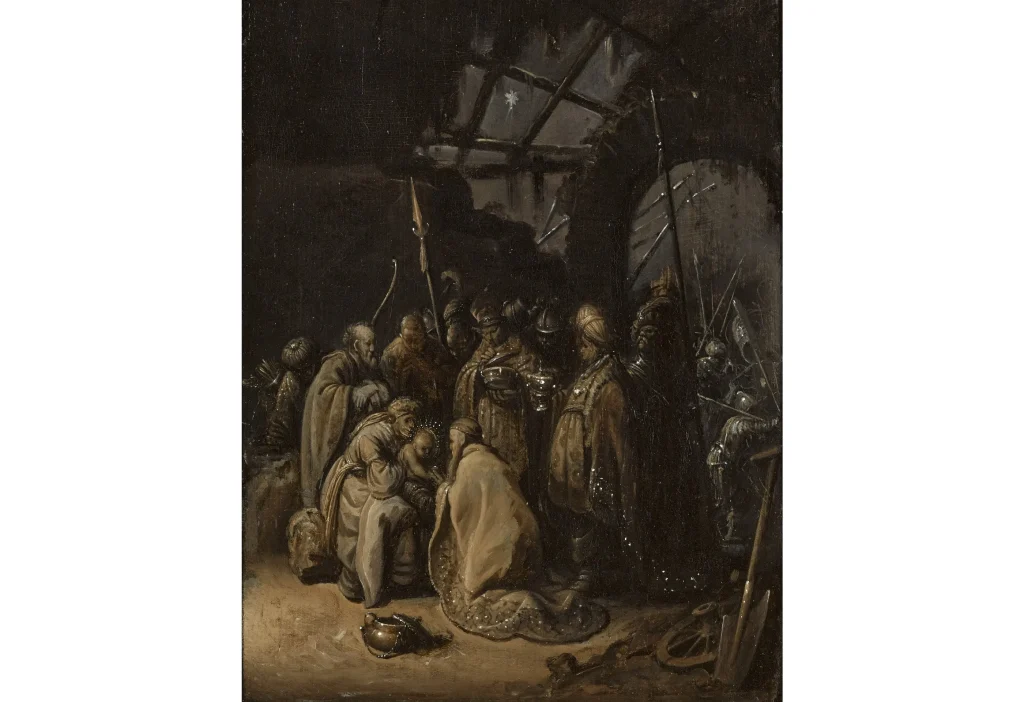A Shift in Attribution Leads to a Staggering Increase in Estimated Value
In the world of art, the value of a painting is often closely tied to its provenance and attribution. Such is the case with “The Adoration of the Kings,” a small nocturne depicting a Biblical scene, which has recently undergone a remarkable transformation in its perceived worth. Previously attributed to the “Circle of Rembrandt,” this masterpiece has now been reattributed to the Dutch master himself, Rembrandt, leading to a staggering increase in its estimated value.
From Christie’s Amsterdam to Sotheby’s London
When “The Adoration of the Kings” last appeared at auction at Christie’s in Amsterdam in 2021, it carried an estimate of €10,000 to €15,000. However, in a jaw-dropping turn of events, Sotheby’s is now presenting this oil on oak panel with a significantly higher estimate of £10 million to £15 million ($12.2 million to $18.4 million) as part of its Old Masters and 19th-century paintings evening sale in London on December 6, 2023. The painting will also benefit from a third-party guarantee, as reported by the Art Newspaper.
A Remarkable Journey of Provenance
“The Adoration of the Kings” embarked on its journey to Sotheby’s via Christie’s in Amsterdam, where it was consigned by a private family collection in Germany. The painting’s provenance history reveals that it was first acquired by the Dutch collector Johannes Carel Hendrik Heldring in 1955. Although it was attributed to the “Circle of Rembrandt” during the 2021 online sale, the artwork generated significant attention and achieved a final price of €860,000, including fees, well surpassing its initial estimate.
The Scholarly Effort Behind the Transformation
Sotheby’s specialist George Gordon played a pivotal role in the reattribution of the work to Rembrandt. This extensive research project spanned 18 months and involved the use of cutting-edge technology, including infrared imaging, to scrutinize the painting’s origins. Notably, the reattribution effort received support from prominent scholars, with Volker Manuth, co-author of a 2019 catalogue raisonné of Rembrandt’s paintings, being among the advocates for the change.
Estimating the Value: A Reflection of Recent Sales
The eye-popping estimate of £10 million to £15 million for “The Adoration of the Kings” is grounded in recent sales of Rembrandt’s works. Notable examples include a self-portrait that achieved £14.5 million (with fees) at Sotheby’s in July 2020 against an estimate of £12 million to £16 million. Additionally, an oil sketch for a head of Christ sold for £9.5 million with fees in 2018, surpassing its estimate of £8 million to £10 million, and found a new home in the Louvre Abu Dhabi.
Insights from Other Auctions
Sotheby’s took into account insights from other auction houses, such as the sale of the panel painting “Abraham and Angels” (ca. 1646) at Sotheby’s in New York in 2021. Although the work was withdrawn from public auction, it was later sold privately within its original estimate of $20 million–$30 million. Furthermore, Christie’s holds the world auction record for Rembrandt, with “Portrait of a Man with Arms Akimbo” (1658) selling for €23.2 million with fees in 2009. This record price was not far from the $25.8 million achieved by another biblical scene by Rembrandt, “Saint James the Greater” (1661), when it was auctioned in 2007.
The transformation of “The Adoration of the Kings” from a work attributed to the “Circle of Rembrandt” to an authentic Rembrandt masterpiece serves as a testament to the enduring allure of art and the profound impact of provenance and attribution on its value. As it graces the auction block at Sotheby’s, all eyes will be on this remarkable painting, eager to witness the culmination of its extraordinary journey in the art world.
Rembrandt’s The Adoration of the Kings is expected to sell for more than $12 million at auction.COURTESY: SOTHEBY’S
We Should Know About the Exercise of Power Hides in Rembrandt Painting

Contributor





